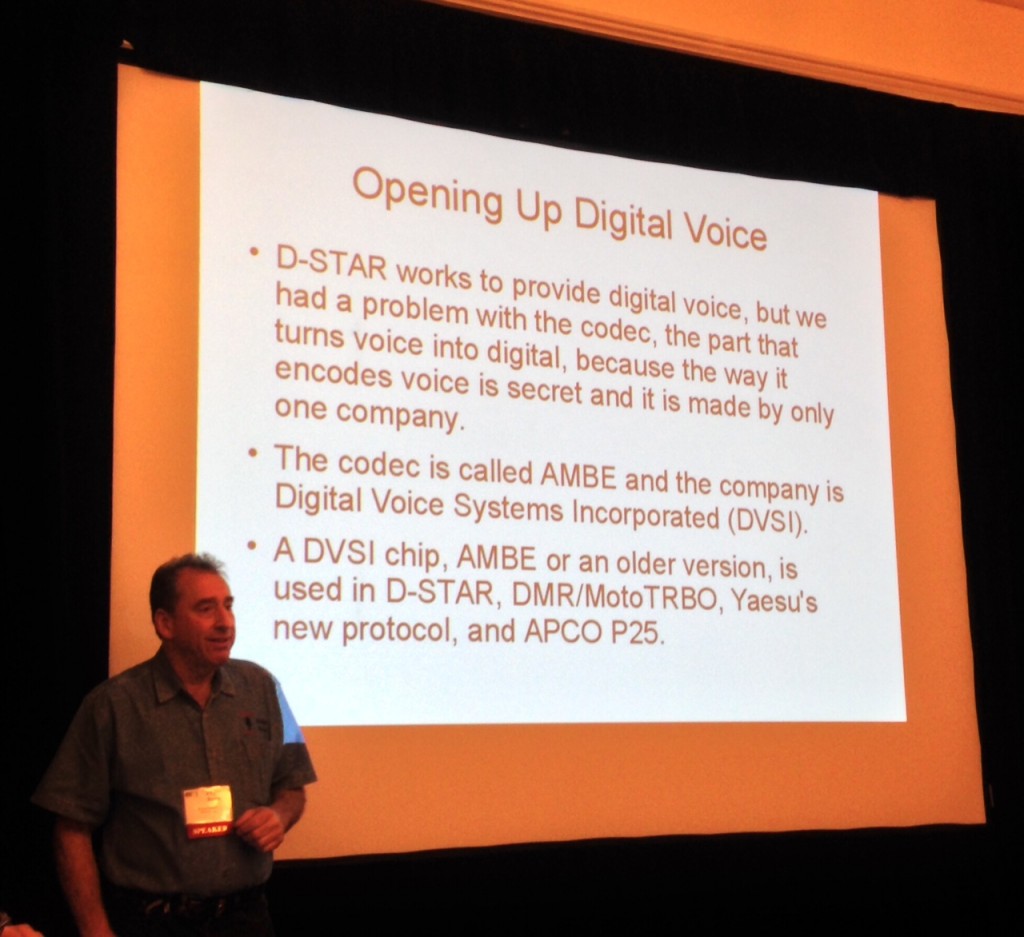 Digital Voice at Pacificon
Digital Voice at Pacificon
Last weekend, I had the privilege of attending the Pacificon amateur radio convention in Santa Clara, something I have been trying to do for several years now. It is a great event, with good technical programs and a super venue.
The most interesting presentation I saw was the one on digital voice (DV) technology by Bruce Perens K6BP. The presentation was mostly about the digital voice known as FreeDV, an open source approach to DV that uses the Codec 2 voice codec for digitally processing/compressing speech.
I won’t cover all of the technical details here but you can follow the links above to go deeper on the topic. The initial FreeDV efforts are focused on the HF bands, using the sound card plus computer approach to implementing DV. This is a good approach since it is a relatively easy way to adopt this technology. (Compare this to VHF/UHF where you need to solve the repeater infrastructure problem to make progress.) FreeDV operates with a bandwidth of 1.25 kHz, narrower that the standard 3 kHz or so SSB signal. FreeDV also has the benefit of degrading gracefully as the signal-to-noise ratio is decreased, with less of a digital dropoff that we see with D-STAR and other DV technologies.
Like many hams, Bruce pointed out the concerns and limitations of the proprietary AMBE chip used in D-STAR, DMR and now the new Yaesu DV system. I totally get this point and support the idea of a an open source codec. On the other hand, this work is coming more than a decade later than the creation of D-STAR. I like to refer to this phenomenon as ”our ideas are better than their products.”
Bruce introduced Chris Testa KB2BMH to talk about the “HT of the Future”. This is a handheld transceiver implemented using Software Defined Radio (SDR) and inspirations from the world of smartphones. As Bruce said, “Why isn’t your HT as smart as your smart phone?” This is similar to the Android HT idea that I blogged about a while back. See Chris’s blog and this HamRadioNow video for more information.
Another presentation that I attended was about D-STAR with several speakers, including Robin AA4RC. The innovation continues to happen in the D-STAR world with a strong theme of using Raspberry Pi computers to create D-STAR hotspots and repeaters. Robin described the “DV Pi” being developed…a DVAP-like daughter board that plugs into a Raspberry Pi. Jim Moen K6JM talked about the many ways you can implement a D-STAR Hotspot. For more info on that see his D-STAR Hotspot page.
There’s much innovation happening in the area of Digital Voice. It got me thinking about it again so I dug out my ICOM D-STAR HT and put my DVAP back on the air.
73, Bob K0NR















So what, exactly, is the problem this solution is intended to solve?
“I like to refer to this phenomenon as ”our ideas are better than their products.” ”
Linux was an idea in 1990 that was better than an existing product. So was the iPhone in 2005.
Jonathan, the problem is the AMBE chip is proprietary and offered by only one company. If they decide to end-of-life the technology or go belly-up, modes that rely on the technology, like D-STAR(tm), are dead in the water. Furthermore, open protocols and technology are inherent to amateur radio, and I would go further and argue they’re mandatory.
Not to mention that if, for example, D-STAR became the de facto standard and everyone was making D-STAR radios and DVSI decided to double (or triple or ??) the price of their chips it would be nearly impossible for a competing product to enter the market. Everyone would just have to pony up the higher price or go analog.
FreeDV uses a CODEC called CODEC2.
The CODEC2 project was pretty much run by hams who wanted a unencumbered CODEC for Amateur Radio. The architect of the codec is one David Rowe, a VK who did pretty much all of the heavy lifting to make the CODEC2 codec successful.
See http://www.rowetel.com/blog/?p=2965
Here is a guy who built it and will tell you how it works. This is the amateur radio spirit.
The problem with AMBE is that you cannot look inside to learn how it works, and you cannot roll your own implementation — you are subject to the DVSI AMBE tax just to use their CODEC. I have no problems with people making money, I just feel that a successful amateur radio mode should not depend on proprietary, single-source, expensive technology.
Bravo CODEC2 and brave FreeDV
“Jonathan, the problem is the AMBE chip is proprietary…”
I suppose I should have been more clear. What problem is digital voice intended to solve? I don’t give a crap about AMBE or D-STAR or FreeDV or whatever until I need to have it in order to make QSO’s. Neither does anybody else. Digital voice won’t be widely supported on HF until a large number of people view it as solving some sort of problem.
I can explain why AM replaced CW and why SSB replaced AM in terms of problems that needed solving. So, what problem is digital voice intended to solve?